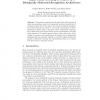53 search results - page 2 / 11 » A Biologically Plausible Algorithm for Reinforcement-shaped ... |
ICIP
2010
IEEE
13 years 2 months ago
2010
IEEE
Representation and measurement are two important issues for saliency models. Different with previous works that learnt sparse features from large scale natural statistics, we prop...
DAGM
2005
Springer
13 years 10 months ago
2005
Springer
We present an approach for the supervised online learning of object representations based on a biologically motivated architecture of visual processing. We use the output of a rece...
IJCNN
2008
IEEE
13 years 11 months ago
2008
IEEE
— Spiking neural networks have been shown capable of simulating sigmoidal artificial neural networks providing promising evidence that they too are universal function approximat...
ICANN
2010
Springer
13 years 5 months ago
2010
Springer
Learning processes allow the central nervous system to learn relationships between stimuli. Even stimuli from different modalities can easily be associated, and these associations ...
ESANN
2001
13 years 5 months ago
2001
In sensorimotor behaviour often a great movement execution variability is combined with a relatively low error in reaching the intended goal. This phenomenon can especially be obse...

